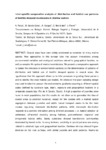Mostrar o rexistro simple do ítem
Inter-specific comparative analysis of distribution and habitat use patterns of benthic decapod crustaceans in shallow waters
| dc.contributor.author | Pallas Lozano, Alicia | |
| dc.contributor.author | García Calvo, Beatriz | |
| dc.contributor.author | Corgos López-Prado, Antonio | |
| dc.contributor.author | Bernárdez Martí, Cristina | |
| dc.contributor.author | Freire, Juan | |
| dc.date.accessioned | 2005-10-28T11:12:58Z | |
| dc.date.available | 2005-10-28T11:12:58Z | |
| dc.date.issued | 2005 | |
| dc.identifier.uri | http://hdl.handle.net/2183/131 | |
| dc.description.abstract | [Abstract] Coastal areas have been widely considered as nurseries for many marine species. New approaches to this concept take into account interactions among environmental variables and ecological variations related to geographical location, as well as complex life cycles of marine invertebrates. We present a comparative approach to assess the relevance of environmental variables on the determination of patterns of distribution and habitat use of benthic decapod species in coastal areas. We hypothesize that this approach allows us to infer processes originating these patterns and to identify the main habitat use models. An intensive fine-grain sampling design was used to take into account the environmental gradients occurring at different spatial scales (defined by substrate type, depth, exposure and geographical location) in a temperate oceanic bay (Ria de A Coruña, Spain). A high proportion of juveniles were found in most populations, but the results do not allow us to generalize the idea of coastal areas as potential nurseries, except for few species with a marked spatial segregation between juveniles and adults. Larval transport seems to be the main process regulating mesoscale distribution patterns, while microscale distribution responds to a complex interaction among different processes, i. e. habitat selection at settlement, differential mortality among habitats, post-settlement dispersal and ontogenetic habitat shifts. Sandy substrates showed low-diversity communities dominated by hermit crabs. In rocky bottoms, variability in spatial patterns was mostly related to substrate type and geographical location. Caridean shrimps showed higher densities on flat rock surfaces, with similar juvenile and adult patterns. Anomuran species occurred mainly on cobbles. Distribution patterns of brachyurans varied among species, but did not change greatly from juveniles to adults | es_ES |
| dc.description.sponsorship | Ministerio de Ciencia y Tecnología; REN2000 –0446MAR | |
| dc.description.sponsorship | Ministerio de Ciencia y Tecnología; REN2003-04816 | |
| dc.description.sponsorship | Xunta de Galicia; XUGA10301B97 | |
| dc.format.mimetype | application/pdf | |
| dc.format.mimetype | text/plain | |
| dc.language.iso | eng | es_ES |
| dc.subject | Spatial scale | es_ES |
| dc.subject | Nursery habitat | es_ES |
| dc.subject | Habitat selection | es_ES |
| dc.subject | Settlement | es_ES |
| dc.subject | Decapod crustaceans | es_ES |
| dc.subject | Coastal ecosystems | es_ES |
| dc.subject | Habitat use | es_ES |
| dc.subject | Distribution | es_ES |
| dc.subject | Ria de A Coruña | es_ES |
| dc.title | Inter-specific comparative analysis of distribution and habitat use patterns of benthic decapod crustaceans in shallow waters | es_ES |
| dc.type | info:eu-repo/semantics/workingPaper | es_ES |
| dc.rights.access | info:eu-repo/semantics/openAccess | es_ES |






